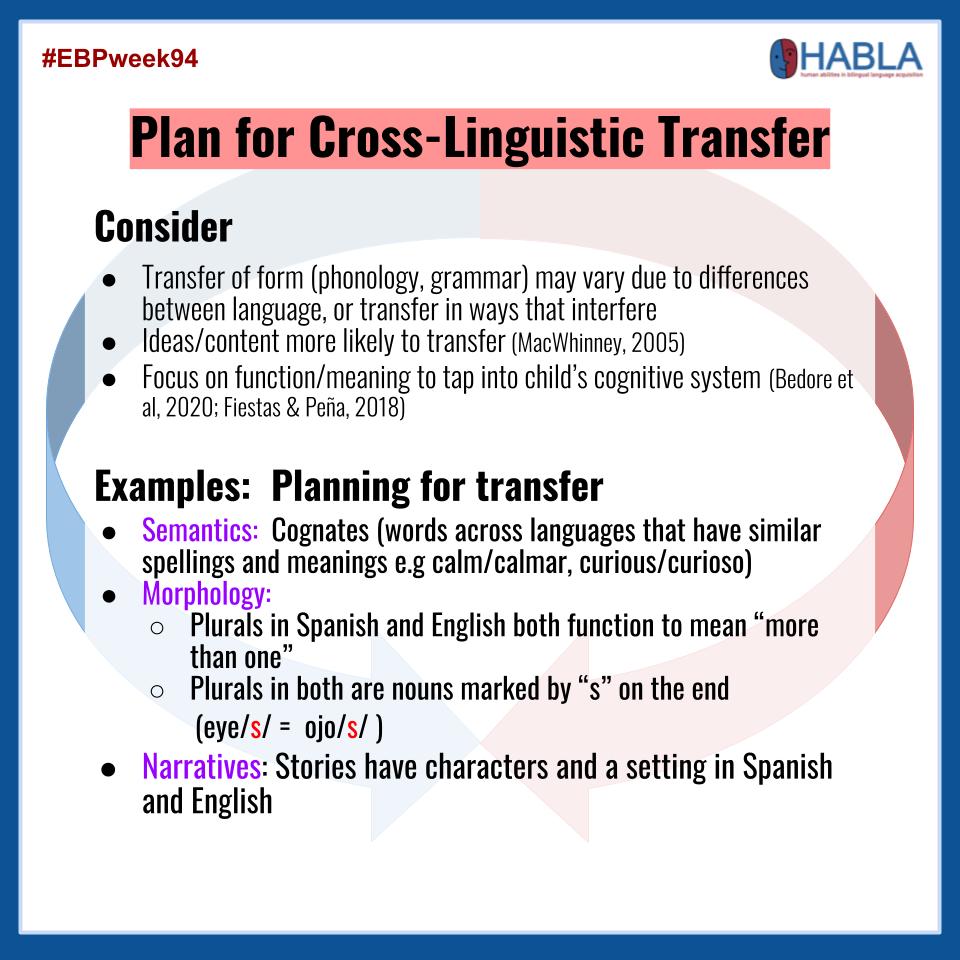SLPs working with bilingual children often ask how to design interventions that promote transfer. We know that it’s not appropriate to take away a child’s home language. We also know that most SLPs (95% or more) only speak one language. So what do we do?
This is a question that my colleagues and I have thought about a lot. I’ve written about our previous studies here and here. We know that not everything transfers. Some parts of language seem to more readily transfer between languages. Usually meaning including story structure, vocabulary and semantics. But form doesn’t transfer as easily. If forms are shared– plural s in Spanish and English for example, they are more likely to transfer. But, it’s less likely that the subjunctive form in Spanish will transfer to English. They are too different.
Still, we wanted to incorporate grammatical goals into our intervention since grammar is an area of difficulty for children with DLD. First, we thought about broad principles of language learning that would support transfer. We drew from MacWhinney’s Unified Model to help us think about transfer:
- Resonance helps to reinforce patterns. We made sure that the vocabulary we used was drawn from the curriculum, and that we used the vocabulary in full phrases and sentences. We reasoned that this would help children learn the grammatical patterns as well as the vocabulary.
- Proceduralization helps children make connections. Rather than teaching grammatical forms in isolation we emphasized features in larger story telling contexts using repeated exposures.
- Internalization is the process by which children may regulate their own actions through language. We expand this by supporting children’s use of L1 in supporting metalinguistic awareness. We propose that this self-talk in the L1 can help form a bridge between L1 and L2 learning.
- Transfer can be negative or positive. In negative transfer, children might incorrectly apply patterns for their L1 to the L2. In positive transfer they might use what they know to leverage use of forms in L2. We tried to promote positive transfer through use of cognates, and through pointing out similarities (and differences) in the grammars of the two languages.
Grammatical Target Selection
In our study, we did not individualize targets for each child. Instead, we identified the kinds of targets that are most difficult for children with DLD in Spanish and in English. We wanted to provide support for grammatical comprehension and production within narrative and expository texts. What’s seems to be difficult for children with DLD is forms that are less salient in the input. We identified constructions at a broad level that are difficult for children with DLD in both Spanish and English and also how they might manifest differently across the two languages. We thought about effective communication through elaboration and precision. Targets we chose included the following:
- Elaborated noun phrases are the building blocks for grammar across both languages. And we could build up the vocabulary words they were learning into these descriptive phases. We included use of prepositions and adjectives. In Spanish, we made sure to focus on number and gender agreement in using adjectives + nouns since this is an area of difficulty for kids with DLD.
- Tense and complex utterances were targeted to help support expression of causal and temporal relationships within the stories that children hear, read, and told.
- Deictic reference – we incorporated use of articles and pronouns from the texts to emphasize different points of view, references, and agreement.
Results indicated significant gains across grammatical forms in Spanish including (clitics, subjunctive, imperfect, and adjective agreement). There were also significant gains in English (even though the intervention was completely in Spanish). Gains we noted in English included 3rd singular, passives, and negatives. We think that through an approach which emphasized expression of complete and elaborated ideas, children started paying more attention to ways they could be more precise in their use of grammar. Thus, in this study, it wasn’t about the specific forms but rather providing the tools (and models) that children could use to express their knowledge through language. The focus wasn’t as much on the “correctness” of use but on elaboration and expression of meaning. And this could be done across both languages.
This is just a small study, but it gives us a glimpse into how we can use these learning principles with broad grammatical targets to support transfer. If you want to read the original paper, you can do so here.

